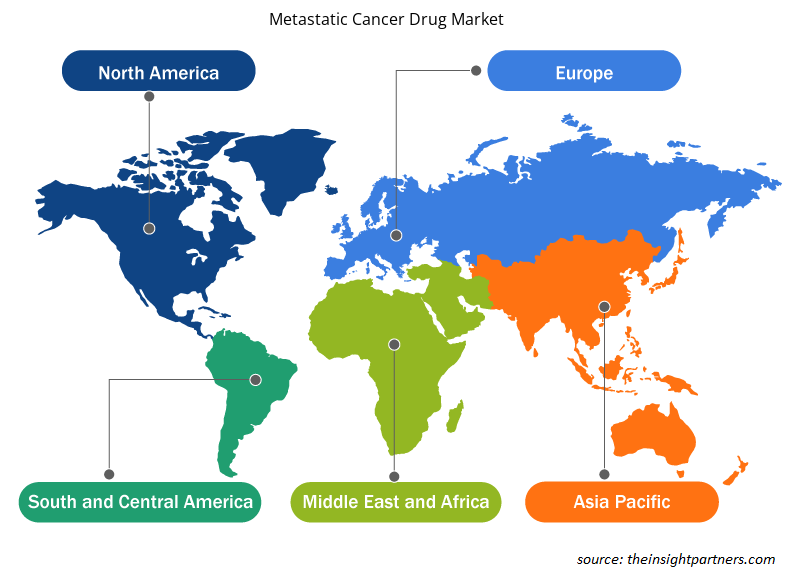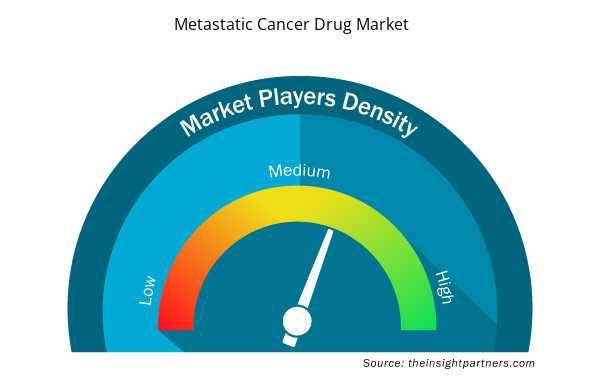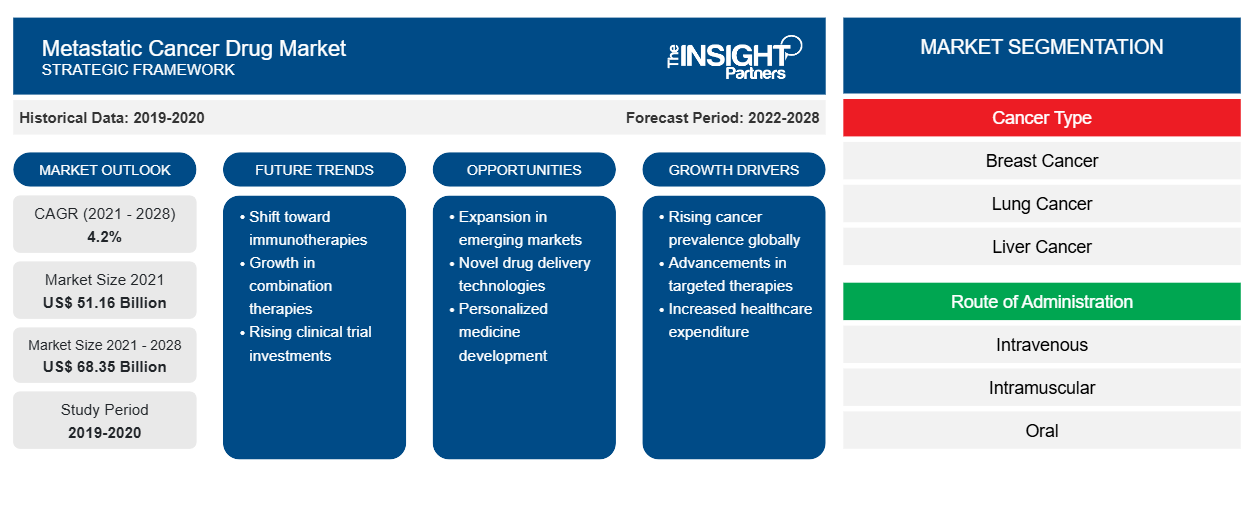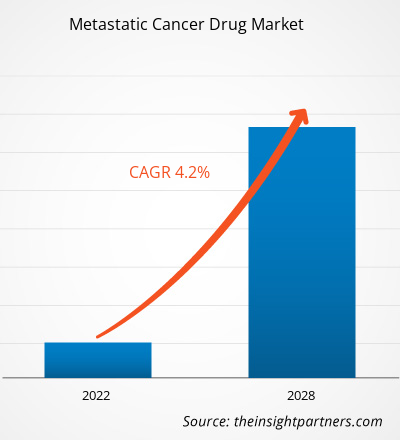[Forschungsbericht] Der Markt für Medikamente gegen metastasierenden Krebs soll von 51.157,97 Millionen US-Dollar im Jahr 2021 auf 68.349,54 Millionen US-Dollar im Jahr 2028 anwachsen. Von 2021 bis 2028 wird mit einer durchschnittlichen jährlichen Wachstumsrate von 4,2 % gerechnet.
Metastasierter Krebs ist definiert als Krebs im fortgeschrittenen Stadium, der sich auf andere Körperteile ausbreitet. Die Medikamente, die zur Behandlung von Krebs im fortgeschrittenen Stadium verwendet werden, heißen metastasierte Krebsmedikamente. Diese Medikamente werden in verschiedenen Therapien eingesetzt, beispielsweise Chemotherapie, Immuntherapie und zielgerichtete Therapie.
Der Markt für Medikamente gegen metastasierenden Krebs wird anhand von Krebsart, Verabreichungsweg, Medikamentenklasse, Produkt, Endverbraucher und Geografie analysiert. Der Markt ist geografisch grob in Nordamerika, Europa, Asien-Pazifik, den Nahen Osten und Afrika sowie Süd- und Mittelamerika unterteilt. Der Bericht bietet Einblicke und eine eingehende Analyse des Marktes und betont Parameter wie die Größe des Marktes für Medikamente gegen metastasierenden Krebs, Trends, technologische Fortschritte und Marktdynamik sowie die Analyse der Wettbewerbslandschaft der weltweit führenden Marktteilnehmer.
Passen Sie diesen Bericht Ihren Anforderungen an
Sie erhalten kostenlose Anpassungen an jedem Bericht, einschließlich Teilen dieses Berichts oder einer Analyse auf Länderebene, eines Excel-Datenpakets sowie tolle Angebote und Rabatte für Start-ups und Universitäten.
- Holen Sie sich die wichtigsten Markttrends aus diesem Bericht.Dieses KOSTENLOSE Beispiel umfasst eine Datenanalyse von Markttrends bis hin zu Schätzungen und Prognosen.
Der Markt für Medikamente gegen metastasierenden Krebs ist auf die hohe Prävalenz von metastasierendem Krebs und staatliche Initiativen zur Förderung der Entwicklung in der Krebsbehandlung zurückzuführen. Die hohen Kosten für Onkologiemedikamente schränken jedoch das Wachstum des Marktes für Medikamente gegen metastasierenden Krebs ein.
Markteinblicke
Hohe Prävalenz von metastasiertem Krebs
Krebs ist eine der Erkrankungen, die Gesellschaften weltweit erheblich beeinträchtigen. Nach Angaben des National Institute of Cancer erkrankten im Jahr 2020 in den USA 1.806.590 Menschen an Krebs, während 606.520 Menschen an Krebs starben. Nach Angaben des American Institute of Cancer Research waren im Jahr 2020 weltweit 18.100 Fälle aktiv. Darüber hinaus gab die Weltgesundheitsorganisation (WHO) an, dass 10.000 Todesfälle oder 1 von 6 Todesfällen weltweit auf Krebs zurückzuführen sind. Die häufigsten Krebsarten sind Lungenkrebs, Brustkrebs, Dickdarmkrebs, Mastdarmkrebs und Prostatakrebs. Die Krankheit tritt jedes Jahr bei 400.000 Kindern auf. Karzinogene Infektionen – darunter Helicobacter pylori, Hepatitis-B-Virus, humanes Papillomavirus (HPV), Hepatitis-C-Virus und Epstein-Barr-Virus – verursachten 2018 weltweit 13 % der Krebsfälle. Die Internationale Agentur für Krebsforschung (IARC) geht davon aus, dass die Zahl der neuen Krebserkrankungen und krebsbedingten Todesfälle weltweit bis 2040 um das 1,6- bis 1,7-Fache ansteigen wird und von 16,4 Millionen im Jahr 2018 auf 29,5 Millionen ansteigen wird. Darüber hinaus wurde laut der American Society of Clinical Oncology im Jahr 2021 in den USA bei 290.560 Menschen (287.850 Frauen und 2.710 Männer) invasiver Brustkrebs diagnostiziert. Brustkrebs bei Frauen hat mittlerweile Lungenkrebs überholt und gilt weltweit als die häufigste Krebsart. Im Jahr 2020 wurde bei etwa 2.261.419 Frauen Brustkrebs diagnostiziert.papillomavirus (HPV), hepatitis C virus, and Epstein-Barr virus—caused 13% of cancer cases in 2018, globally. The International Agency for Research on Cancer (IARC) projects that the number of new cancer cases and cancer-related deaths worldwide will grow 1.6–1.7 fold by 2040 to reach 29.5 million and from 16.4 million in 2018. Further, according to the American Society of Clinical Oncology, in 2021, 290,560 people (287,850 women and 2,710 men) in the US were diagnosed with invasive breast cancer. Breast cancer in females has now surpassed lung cancer and is recognized as the most common cancer type worldwide. Approximately, 2,261,419 women were diagnosed with breast cancer in 2020.
Unter all den Beobachtungen, die in den letzten Jahrzehnten in den USA über Krebs aufgezeichnet wurden, ist eine Statistik unverändert geblieben: Metastasierter Krebs ist für bis zu 90 % aller Krebstodesfälle pro Jahr verantwortlich. Diese Zahlen haben Ärzte und Forscher motiviert, neue Wege zur Behandlung von Metastasen zu finden, die auftreten, wenn sich Krebs über seinen Ursprungsort hinaus ausbreitet. In den USA wurde bei 6 % der Frauen bei der Erstdiagnose metastasierter Brustkrebs diagnostiziert. Ein solcher Anstieg der Prävalenz von metastasiertem Krebs treibt das Wachstum des Marktes für Medikamente gegen metastasierten Krebs voran.
In Nordamerika wird für Kanada im Prognosezeitraum ein beträchtliches Wachstum erwartet. Die wichtigsten in Kanada verwendeten Immuntherapiemedikamente sind Ipilimumab (Yervoy), Pembrolizumab (Keytruda), Nivolumab (Opdivo), Durvalumab (Imfinzi) und Atezolizumab (Tecentriq). Es gibt jedoch auch andere Checkpoint-Inhibitoren, die für das allgemeine Marktwachstum sorgen dürften.immunotherapy drugs used in Canada are ipilimumab (Yervoy), pembrolizumab (Keytruda), nivolumab (Opdivo), durvalumab (Imfinzi) and atezolizumab (Tecentriq). However, there are other checkpoint inhibitors poised to bring the overall market growth.
Erkenntnisse auf Basis der Krebsart
Basierend auf der Krebsart ist der Markt für Medikamente gegen metastasierenden Krebs in Brustkrebs, Lungenkrebs, Leberkrebs , hämatologischen Krebs , Hirnkrebs, Prostatakrebs, Bauchspeicheldrüsenkrebs und andere unterteilt. Das Brustkrebssegment hatte 2021 den größten Marktanteil und wird im Prognosezeitraum voraussichtlich die höchste durchschnittliche jährliche Wachstumsrate verzeichnen.CAGR during the forecast period.
Einblicke auf Grundlage der Verabreichungswege
Basierend auf der Verabreichungsart ist der Markt für Medikamente gegen metastasierenden Krebs in intravenöse, intramuskuläre, orale und andere unterteilt. Das intravenöse Segment hatte 2021 den größten Marktanteil und wird im Prognosezeitraum voraussichtlich die höchste durchschnittliche jährliche Wachstumsrate verzeichnen.CAGR during the forecast period.
Erkenntnisse auf Basis von Arzneimittelklassen
Basierend auf der Medikamentenklasse ist der Markt für Medikamente gegen metastasierenden Krebs in HER2-Inhibitoren, Immuncheckpoint-Inhibitoren , PARP-Inhibitoren, Kinase-Inhibitoren und andere unterteilt. Das Segment der PARP-Inhibitoren hatte 2021 den größten Marktanteil. Es wird jedoch erwartet, dass das Segment der HER2-Inhibitoren im Prognosezeitraum die höchste durchschnittliche jährliche Wachstumsrate verzeichnet.PARP inhibitors, kinase inhibitors, and others. The PARP inhibitors segment accounted for the largest market share in 2021. However, the HER2 inhibitors segment is expected to register the highest CAGR during the forecast period.
Regionale Einblicke in den Markt für Medikamente gegen metastasierten Krebs
Die regionalen Trends und Faktoren, die den Markt für Medikamente gegen metastasierten Krebs im Prognosezeitraum beeinflussen, wurden von den Analysten von Insight Partners ausführlich erläutert. In diesem Abschnitt werden auch die Marktsegmente und die Geografie von Medikamenten gegen metastasierten Krebs in Nordamerika, Europa, im asiatisch-pazifischen Raum, im Nahen Osten und Afrika sowie in Süd- und Mittelamerika erörtert.

- Erhalten Sie regionale Daten zum Markt für Medikamente gegen metastasierten Krebs
Umfang des Marktberichts über Medikamente gegen metastasierten Krebs
| Berichtsattribut | Details |
|---|---|
| Marktgröße im Jahr 2021 | 51,16 Milliarden US-Dollar |
| Marktgröße bis 2028 | 68,35 Milliarden US-Dollar |
| Globale CAGR (2021 - 2028) | 4,2 % |
| Historische Daten | 2019-2020 |
| Prognosezeitraum | 2022–2028 |
| Abgedeckte Segmente | Nach Krebsart
|
| Abgedeckte Regionen und Länder | Nordamerika
|
| Marktführer und wichtige Unternehmensprofile |
|
Dichte der Marktteilnehmer für Medikamente gegen metastasierenden Krebs: Auswirkungen auf die Geschäftsdynamik verstehen
Der Markt für Medikamente gegen metastasierten Krebs wächst rasant. Dies wird durch die steigende Nachfrage der Endverbraucher aufgrund von Faktoren wie sich entwickelnden Verbraucherpräferenzen, technologischen Fortschritten und einem größeren Bewusstsein für die Vorteile des Produkts vorangetrieben. Mit der steigenden Nachfrage erweitern Unternehmen ihr Angebot, entwickeln Innovationen, um die Bedürfnisse der Verbraucher zu erfüllen, und nutzen neue Trends, was das Marktwachstum weiter ankurbelt.
Die Marktteilnehmerdichte bezieht sich auf die Verteilung von Firmen oder Unternehmen, die in einem bestimmten Markt oder einer bestimmten Branche tätig sind. Sie gibt an, wie viele Wettbewerber (Marktteilnehmer) in einem bestimmten Marktraum im Verhältnis zu seiner Größe oder seinem gesamten Marktwert präsent sind.
Die wichtigsten auf dem Markt für Medikamente gegen metastasierten Krebs tätigen Unternehmen sind:
- AbbVie Inc.
- Amgen Inc.
- Bristol-Myers Squibb Company
- F. HOFFMANN-LA ROCHE LTD.
- Novartis AG
Haftungsausschluss : Die oben aufgeführten Unternehmen sind nicht in einer bestimmten Reihenfolge aufgeführt.

- Überblick über die wichtigsten Akteure auf dem Markt für Medikamente gegen metastasierende Krebs
Produktbasierte Einblicke
Basierend auf dem Produkt ist der Markt für Medikamente gegen metastasierenden Krebs in Marken-, Generika- und Biosimilars-Produkte unterteilt. Das Markensegment hatte 2021 einen größeren Marktanteil. Es wird jedoch geschätzt, dass das Segment Generika und Biosimilars im Prognosezeitraum eine höhere durchschnittliche jährliche Wachstumsrate verzeichnen wird.
Endbenutzerbasierte Erkenntnisse
Basierend auf dem Endverbraucher ist der Markt für Medikamente gegen metastasierenden Krebs in Krankenhäuser, Fachkliniken und andere unterteilt. Das Krankenhaussegment hatte 2021 den größten Anteil, während das Segment der Fachkliniken im Prognosezeitraum voraussichtlich die höchste durchschnittliche jährliche Wachstumsrate verzeichnen wird.
Produkteinführungen und -zulassungen gehören zu den häufig angewandten Strategien von Unternehmen, um ihre globale Präsenz und ihr Produktportfolio zu erweitern. Die Akteure auf dem Markt für Medikamente gegen metastasierenden Krebs konzentrieren sich auch auf die Partnerschaftsstrategie, um ihren Kundenstamm zu vergrößern, was ihnen wiederum ermöglicht, ihren Markennamen weltweit aufrechtzuerhalten. Sie zielen darauf ab, ihre Marktanteile durch die Entwicklung innovativer Produkte auszubauen.
AbbVie Inc.; Amgen Inc.; Bristol-Myers Squibb Company; F. HOFFMANN-LA ROCHE LTD.; Novartis AG; ASTRAZENECA PLC.; Eli Lilly and Company; MERCK KGaA; und Pfizer Inc. (Arena Pharmaceutical GmbH); und Johnson and Johnson Services, Inc. sind die führenden Unternehmen auf dem Markt für Medikamente gegen metastasierenden Krebs.
- Historische Analyse (2 Jahre), Basisjahr, Prognose (7 Jahre) mit CAGR
- PEST- und SWOT-Analyse
- Marktgröße Wert/Volumen – Global, Regional, Land
- Branche und Wettbewerbsumfeld
- Excel-Datensatz



Report Coverage
Revenue forecast, Company Analysis, Industry landscape, Growth factors, and Trends

Segment Covered
This text is related
to segments covered.

Regional Scope
North America, Europe, Asia Pacific, Middle East & Africa, South & Central America

Country Scope
This text is related
to country scope.
Häufig gestellte Fragen
Cancer that spreads from where it started to a distant part of the body is called metastatic cancer. The process by which cancer cells spread to other parts of the body is called metastasis. Metastatic cancer is an advanced cancer stage that spread to the other body parts and the drugs used for the treatment of advanced stage cancer are known as metastatic cancer drugs. These drugs are used through various therapies such as chemotherapy, immunotherapy, and targeted therapy.
The factors that are driving and restraining factors that will affect the metastatic cancer drugs market in the coming years. The growth of the market is attributed to some key driving factors such as increasing prevalence of cancer and government initiatives to support drug developments for cancer treatment. However, high cost of oncology drugs is likely to hinder the market growth.
The metastatic cancer drug market, by cancer type, is bifurcated into breast cancer, lung cancer, liver cancer, hematological cancer, brain cancer, prostate cancer, pancreatic cancer, and others. The breast cancer segment held the largest share in 2021 and is anticipated to register the highest CAGR during the forecast period.
The metastatic cancer drug market majorly consists of the players such as AbbVie Inc., Amgen Inc., Bristol-Myers Squibb Company, F. HOFFMANN-LA ROCHE LTD., Novartis AG, ASTRAZENECA PLC., Eli Lilly and Company, MERCK KGaA, and Pfizer Inc. (Arena Pharmaceutical GmbH) amongst others.
Trends and growth analysis reports related to Life Sciences : READ MORE..
The List of Companies - Metastatic Cancer Drug Market
- AbbVie Inc.
- Amgen Inc.
- Bristol-Myers Squibb Company
- F. HOFFMANN-LA ROCHE LTD.
- Novartis AG
- ASTRAZENECA PLC.
- Eli Lilly and Company
- MERCK KGaA
- Pfizer Inc. (Arena Pharmaceutical GmbH)
The Insight Partners performs research in 4 major stages: Data Collection & Secondary Research, Primary Research, Data Analysis and Data Triangulation & Final Review.
- Data Collection and Secondary Research:
As a market research and consulting firm operating from a decade, we have published and advised several client across the globe. First step for any study will start with an assessment of currently available data and insights from existing reports. Further, historical and current market information is collected from Investor Presentations, Annual Reports, SEC Filings, etc., and other information related to company’s performance and market positioning are gathered from Paid Databases (Factiva, Hoovers, and Reuters) and various other publications available in public domain.
Several associations trade associates, technical forums, institutes, societies and organization are accessed to gain technical as well as market related insights through their publications such as research papers, blogs and press releases related to the studies are referred to get cues about the market. Further, white papers, journals, magazines, and other news articles published in last 3 years are scrutinized and analyzed to understand the current market trends.
- Primary Research:
The primarily interview analysis comprise of data obtained from industry participants interview and answers to survey questions gathered by in-house primary team.
For primary research, interviews are conducted with industry experts/CEOs/Marketing Managers/VPs/Subject Matter Experts from both demand and supply side to get a 360-degree view of the market. The primary team conducts several interviews based on the complexity of the markets to understand the various market trends and dynamics which makes research more credible and precise.
A typical research interview fulfils the following functions:
- Provides first-hand information on the market size, market trends, growth trends, competitive landscape, and outlook
- Validates and strengthens in-house secondary research findings
- Develops the analysis team’s expertise and market understanding
Primary research involves email interactions and telephone interviews for each market, category, segment, and sub-segment across geographies. The participants who typically take part in such a process include, but are not limited to:
- Industry participants: VPs, business development managers, market intelligence managers and national sales managers
- Outside experts: Valuation experts, research analysts and key opinion leaders specializing in the electronics and semiconductor industry.
Below is the breakup of our primary respondents by company, designation, and region:

Once we receive the confirmation from primary research sources or primary respondents, we finalize the base year market estimation and forecast the data as per the macroeconomic and microeconomic factors assessed during data collection.
- Data Analysis:
Once data is validated through both secondary as well as primary respondents, we finalize the market estimations by hypothesis formulation and factor analysis at regional and country level.
- Macro-Economic Factor Analysis:
We analyse macroeconomic indicators such the gross domestic product (GDP), increase in the demand for goods and services across industries, technological advancement, regional economic growth, governmental policies, the influence of COVID-19, PEST analysis, and other aspects. This analysis aids in setting benchmarks for various nations/regions and approximating market splits. Additionally, the general trend of the aforementioned components aid in determining the market's development possibilities.
- Country Level Data:
Various factors that are especially aligned to the country are taken into account to determine the market size for a certain area and country, including the presence of vendors, such as headquarters and offices, the country's GDP, demand patterns, and industry growth. To comprehend the market dynamics for the nation, a number of growth variables, inhibitors, application areas, and current market trends are researched. The aforementioned elements aid in determining the country's overall market's growth potential.
- Company Profile:
The “Table of Contents” is formulated by listing and analyzing more than 25 - 30 companies operating in the market ecosystem across geographies. However, we profile only 10 companies as a standard practice in our syndicate reports. These 10 companies comprise leading, emerging, and regional players. Nonetheless, our analysis is not restricted to the 10 listed companies, we also analyze other companies present in the market to develop a holistic view and understand the prevailing trends. The “Company Profiles” section in the report covers key facts, business description, products & services, financial information, SWOT analysis, and key developments. The financial information presented is extracted from the annual reports and official documents of the publicly listed companies. Upon collecting the information for the sections of respective companies, we verify them via various primary sources and then compile the data in respective company profiles. The company level information helps us in deriving the base number as well as in forecasting the market size.
- Developing Base Number:
Aggregation of sales statistics (2020-2022) and macro-economic factor, and other secondary and primary research insights are utilized to arrive at base number and related market shares for 2022. The data gaps are identified in this step and relevant market data is analyzed, collected from paid primary interviews or databases. On finalizing the base year market size, forecasts are developed on the basis of macro-economic, industry and market growth factors and company level analysis.
- Data Triangulation and Final Review:
The market findings and base year market size calculations are validated from supply as well as demand side. Demand side validations are based on macro-economic factor analysis and benchmarks for respective regions and countries. In case of supply side validations, revenues of major companies are estimated (in case not available) based on industry benchmark, approximate number of employees, product portfolio, and primary interviews revenues are gathered. Further revenue from target product/service segment is assessed to avoid overshooting of market statistics. In case of heavy deviations between supply and demand side values, all thes steps are repeated to achieve synchronization.
We follow an iterative model, wherein we share our research findings with Subject Matter Experts (SME’s) and Key Opinion Leaders (KOLs) until consensus view of the market is not formulated – this model negates any drastic deviation in the opinions of experts. Only validated and universally acceptable research findings are quoted in our reports.
We have important check points that we use to validate our research findings – which we call – data triangulation, where we validate the information, we generate from secondary sources with primary interviews and then we re-validate with our internal data bases and Subject matter experts. This comprehensive model enables us to deliver high quality, reliable data in shortest possible time.


 Holen Sie sich ein kostenloses Muster für diesen Bericht
Holen Sie sich ein kostenloses Muster für diesen Bericht